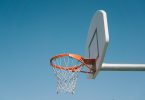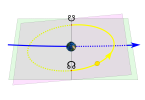A moving screen is a common basketball tactic used to create space for a teammate to shoot or drive to the basket. It involves a player setting a screen on a defender while moving, rather than standing still. This can be a highly effective strategy if executed properly, but it can also result in a foul if the screener makes contact with the defender. In the NBA, a moving screen is defined as a foul that occurs when an offensive player sets a screen on a defender who is not in a legal guarding position, and the screener is moving at the time of contact.
This type of foul is often called on players who try to set screens while still in motion, or who make contact with the defender before they have had a chance to establish their position.
While a moving screen can be a valuable tool for creating scoring opportunities, it is important for players to understand the rules and limitations surrounding this tactic.
By staying aware of the defender’s position and avoiding unnecessary contact, players can effectively use moving screens to their advantage while minimizing the risk of committing a foul.
Definition of Moving Screen in NBA
A moving screen is a violation in basketball that occurs when a player on the offensive team sets a screen while in motion, making contact with a defender and impeding their ability to defend the ball handler. The NBA defines a moving screen as “any illegal action by a player (offensive or defensive) who causes contact with an opponent while moving.”
Moving screens are typically called by referees when the screener does not establish a legal position before making contact with the defender. A legal screen is one where the screener is stationary and does not move into the path of the defender.
The purpose of a screen is to create space for the ball handler to get open for a shot or to drive to the basket. However, a moving screen is considered a violation because it gives the offensive player an unfair advantage by impeding the defender’s ability to move freely on the court.
Players who commit a moving screen violation are typically assessed a personal foul, which counts towards their team’s total fouls for the game. If a player accumulates too many personal fouls during a game, they may be disqualified from further play.
Understanding Moving Screen
A moving screen is a common foul in basketball that occurs when an offensive player sets a screen for a teammate while still in motion. The NBA has a specific definition for a moving screen, which is when “an offensive player moves into and makes contact with a defender who is stationary or moving in a direction other than parallel to the endline.”
The purpose of a screen is to create space for the ball handler or a teammate to get open for a shot or a pass. However, if the screener moves while setting the screen and makes contact with a defender, it is considered a moving screen and a foul is called.
Moving screens are often called on big men who set screens for guards, as they are more likely to move while setting the screen due to their size and weight. It is important for players to set screens correctly and avoid moving while doing so to prevent fouls and turnovers.
In addition to being a foul, a moving screen can also result in a turnover if the ball handler is called for an offensive foul. This can be costly in close games and can swing the momentum in favor of the opposing team. Therefore, it is crucial for players to understand the rules and techniques for setting screens to avoid costly mistakes.
Overall, understanding the definition and consequences of a moving screen is essential for players at all levels of basketball. By setting screens correctly and avoiding fouls, players can create more scoring opportunities for their team and improve their chances of winning.
Implications of Moving Screen
A moving screen is a violation in basketball where an offensive player intentionally or unintentionally moves while setting a screen, making contact with a defender and preventing them from guarding the offensive player with the ball. This violation can have several implications, affecting the outcome of the game.
Firstly, a moving screen violation results in a turnover, giving the ball to the opposing team. This can be detrimental to the offensive team, as it takes away their opportunity to score and gives the opposing team a chance to score.
Secondly, a moving screen can lead to injuries. When an offensive player moves while setting a screen, it can catch a defender off guard and cause them to collide with the offensive player. This collision can result in injuries such as concussions, sprains, and fractures.
Thirdly, a moving screen can cause frustration and anger among players and coaches. When a moving screen is called, it can be seen as a subjective call, leading to disagreements and arguments among players and coaches. This can create a negative atmosphere on the court and affect the overall performance of the team.
Lastly, a moving screen can affect the momentum of the game. If a moving screen is called against a team that is on a scoring run, it can break their momentum and give the opposing team a chance to catch up. This can ultimately affect the outcome of the game.
How Referees Identify Moving Screen
When it comes to identifying a moving screen in NBA, referees have a few key factors that they consider. First and foremost, they look at the position of the screener and the defender. If the screener is not stationary and moves into the defender’s path, this is typically considered a moving screen.
Another factor that referees consider is the timing of the screen. If the screener sets the screen before the defender has a chance to react and adjust their position, this can be considered an illegal or moving screen. Referees also pay attention to the angle of the screen and whether the screener’s feet are set. If the screener’s feet are not set, this can be an indicator of a moving screen.
Referees also look for any additional actions by the screener that may contribute to a moving screen, such as extending their arms or leaning into the defender. These actions can create more contact and make it more difficult for the defender to navigate around the screen.
It’s important to note that referees must make these calls in real-time, often in the midst of a fast-paced game. They rely on their training and experience to make quick and accurate decisions on whether a screen is legal or illegal.
Historical Context of Moving Screen
Moving screens have been a part of basketball since the earliest days of the game. However, the rules surrounding them have evolved over time.
In the early days of basketball, screens were often used to create space for a shooter or to free up a teammate for a drive to the basket. However, these screens were often illegal, as they involved the screener moving into the path of the defender.
In the 1950s and 1960s, the NBA began to crack down on illegal screens, and the rules were updated to require the screener to be stationary when setting a screen. This meant that the screener could not move into the path of the defender, but instead had to set the screen and hold their position.
Over the years, the rules surrounding moving screens have continued to evolve. In the 1990s, the NBA began to crack down on screens that were set too aggressively, and introduced rules to prevent players from using their hands or arms to hold onto defenders.
Today, the NBA has very strict rules surrounding moving screens. Screens must be set in a stationary position, and the screener cannot move into the path of the defender. Additionally, the screener cannot use their hands or arms to hold onto the defender, and must maintain a legal position throughout the screen.
Overall, the evolution of the rules surrounding moving screens has been driven by a desire to create a fair and competitive game, while also protecting the safety of the players on the court. While the rules may continue to evolve in the future, the basic principles of a legal screen are likely to remain the same.
Famous Instances of Moving Screen
Moving screens have been a part of NBA games for decades. While they are often overlooked, they can have a significant impact on the outcome of a game. Here are a few famous instances of moving screens in NBA history.
John Stockton’s Moving Screen
One of the most famous examples of a moving screen occurred during Game 6 of the 1998 NBA Finals between the Utah Jazz and the Chicago Bulls.
With just seconds left in the game, the Jazz had a chance to tie the score and force a Game 7. John Stockton attempted to set a screen on Michael Jordan, but he moved his feet, causing Jordan to stumble and giving Stockton a clear path to the basket. The referees did not call a foul, and the Bulls went on to win the championship.
Draymond Green’s Moving Screen
In Game 5 of the 2016 NBA Finals between the Golden State Warriors and the Cleveland Cavaliers, Draymond Green set a moving screen on LeBron James.
The screen was so blatant that James fell to the ground, and the referees called a foul on Green. However, the foul was later upgraded to a flagrant foul, and Green was suspended for Game 6. The Warriors went on to lose the series in seven games.
Kevin Garnett’s Moving Screen
During Game 1 of the 2008 NBA Finals between the Boston Celtics and the Los Angeles Lakers, Kevin Garnett set a moving screen on Sasha Vujacic. The screen was so hard that Vujacic fell to the ground, and the referees called a foul on Garnett. The Celtics went on to win the championship in six games.
Moving screens are a common occurrence in the NBA, but they can have a significant impact on the outcome of a game. These famous instances show just how important it is for players to set legal screens and for referees to make the right calls.
Controversies Surrounding Moving Screen
Moving screens have been a point of controversy in the NBA for years. While they are a common tactic used by teams to create open shots, they can also be dangerous and lead to injuries.
One of the main controversies surrounding moving screens is the issue of player safety. When a player sets a moving screen, they can easily collide with a defender and cause injury. This is especially true when the screener is significantly larger than the defender, as the impact can be much greater.
Another issue with moving screens is the difficulty in determining whether or not they are legal. The rules surrounding moving screens are somewhat vague, and referees often have to make split-second decisions about whether or not a screen was set legally.
This can lead to frustration among players and coaches, as they may feel that they are being unfairly penalized for something that is difficult to control.
Finally, some players and coaches have criticized the use of moving screens as a cheap tactic that takes away from the skill of the game. They argue that setting a moving screen is an easy way to create open shots, rather than relying on skill and strategy to create scoring opportunities.
Overall, while moving screens are a common tactic in the NBA, they are also a source of controversy and frustration for many players and coaches. As the league continues to evolve and adapt to new rules and regulations, it will be interesting to see how the issue of moving screens is addressed in the future.
Conclusion
In conclusion, a moving screen is a common basketball technique used to create space for the ball handler. It involves a player setting a screen while moving, which can often result in a foul being called if the player does not establish a stationary position before contact is made. The NBA has specific rules and regulations regarding moving screens to ensure player safety and fair play.
It is important for players to understand the rules and regulations surrounding moving screens to avoid committing a foul and potentially hurting themselves or other players.
Coaches should also teach their players proper techniques for setting screens to avoid fouls and maximize the effectiveness of the play.
Overall, while a moving screen can be a useful technique in basketball, it is important for players to use it within the bounds of the rules and regulations set forth by the NBA. By doing so, they can create effective scoring opportunities while maintaining a safe and fair playing environment.






